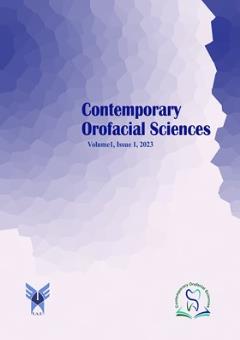Semi-nutritious Liquids effect on Shear Bond Strength of Repaired Composite with Universal bonding
محورهای موضوعی : Restorative and Aesthetic DentistrySomayeh shiyasi 1 , Parvin Mirzakouchaki 2 , Mina Ahmadi 3
1 - school of dentistry, Islamic Azad University, Isfahan (khorasgan) Branch, Isfahan, Iran
2 - Department of Operative dentistry, Faculty of dentistry, Isfahan (khorasgan) Branch, Islamic Azad university, Isfahan, Iran
3 - Department of Operative Dentistry, School of Dentistry, Islamic Azad University, Isfahan (Khorasgan) Branch, Isfahan, Iran
کلید واژه: Composite, Shear Bond Strength, G-premium bond and Non-nutrient Liquids,
چکیده مقاله :
Background: Composite resins undergo changes in properties due to various oral irritations over time. This study analyzed the effect of semi-nutritious liquids on the shear bond strength of repaired composite with universal bonding Materials and methods: This laboratory experiment used 80 samples of rectangular cubes made of Z250 composite. The samples were subjected to Thermocycling in an incubator and divided into four experi-mental groups, one control group, and stored in different solutions for seven days. After the aging process, the samples were roughened, bonding was applied, and a composite cylinder was placed on the previous composite. The bond strength was then calculated with an Instron device, and the data were analyzed using one-way ANOVA and Bonferroni's post hoc test (α=0.05). Results: Maximum average of bond strength in semi-nutrient liquids was recorded in descending order 25.53MPa for saliva , distilled water (20.24MPa), ethanol (18.04 MPa), citric acid (16.24 MPa), and Hep-tane (9.83 MPa), respectively. Conclusions: Artificial saliva yielded the highest average bond strength, while distilled water, ethanol, citric acid, and heptane resulted in decreasing bond strength.
Background: Composite resins undergo changes in properties due to various oral irritations over time. This study analyzed the effect of semi-nutritious liquids on the shear bond strength of repaired composite with universal bonding Materials and methods: This laboratory experiment used 80 samples of rectangular cubes made of Z250 composite. The samples were subjected to Thermocycling in an incubator and divided into four experi-mental groups, one control group, and stored in different solutions for seven days. After the aging process, the samples were roughened, bonding was applied, and a composite cylinder was placed on the previous composite. The bond strength was then calculated with an Instron device, and the data were analyzed using one-way ANOVA and Bonferroni's post hoc test (α=0.05). Results: Maximum average of bond strength in semi-nutrient liquids was recorded in descending order 25.53MPa for saliva , distilled water (20.24MPa), ethanol (18.04 MPa), citric acid (16.24 MPa), and Hep-tane (9.83 MPa), respectively. Conclusions: Artificial saliva yielded the highest average bond strength, while distilled water, ethanol, citric acid, and heptane resulted in decreasing bond strength.


